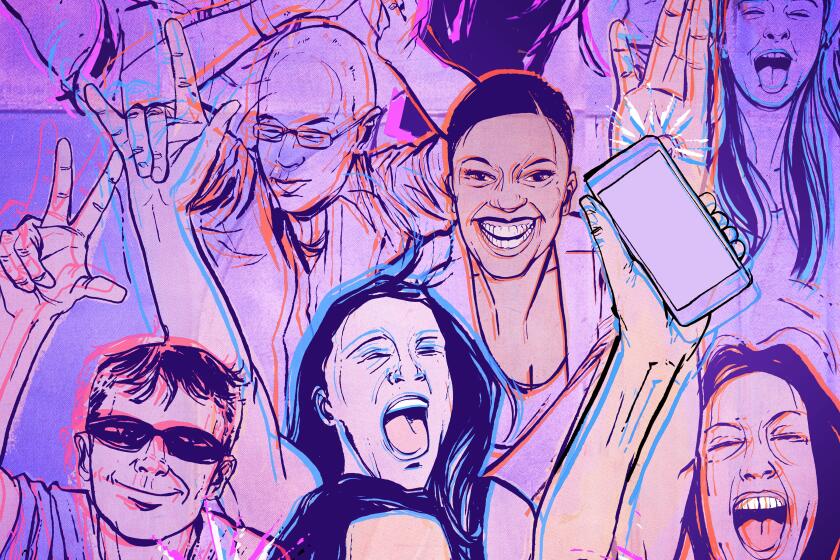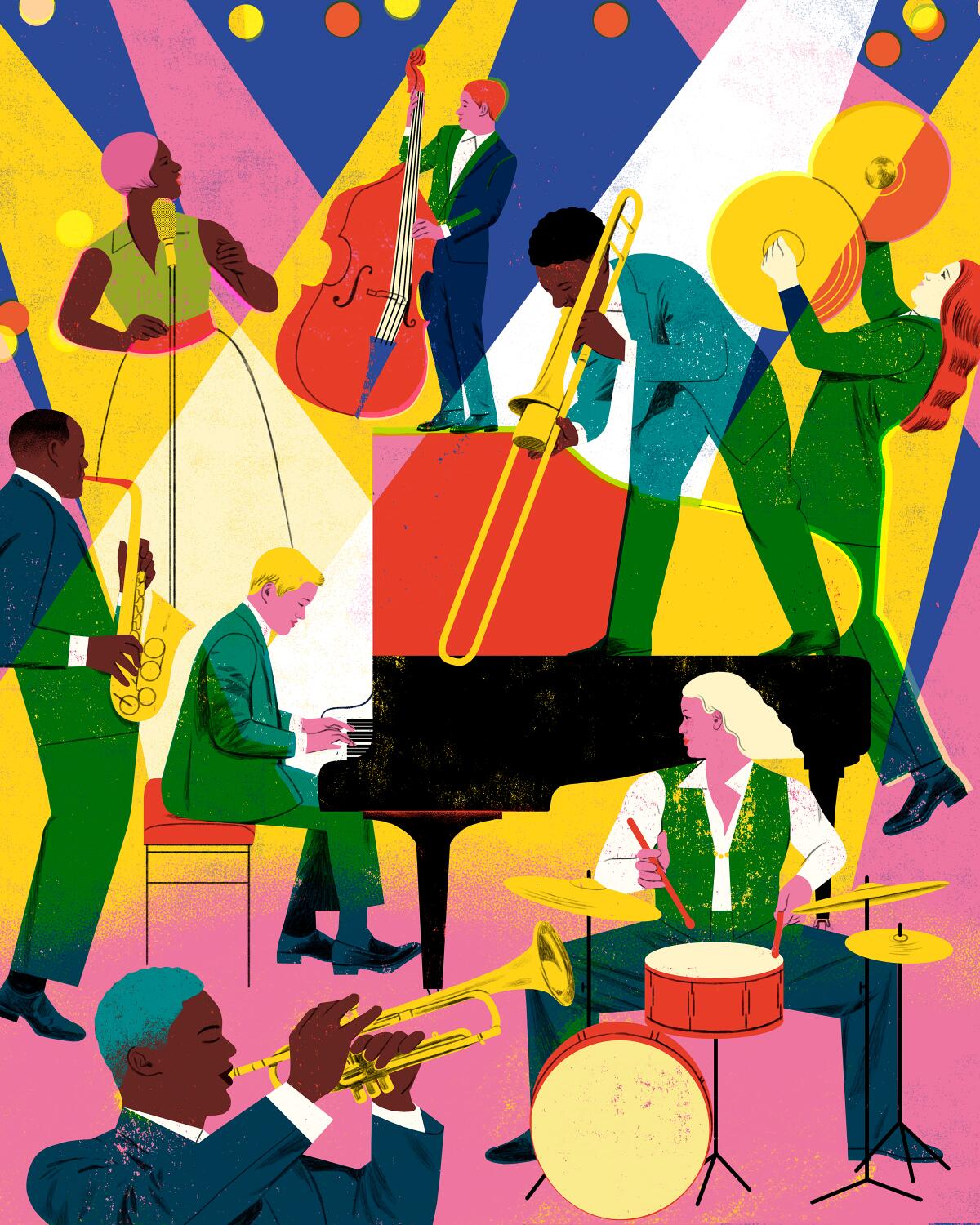
11 vibrant spots where jazz still reigns in L.A.
- Share via
If you love jazz, you have to be alert. That’s in part because the music is all about savoring spontaneity, but also because live jazz is rare and getting rarer.
In an entertainment capital that very nearly trembles with music of all genres, only about a dozen clubs in Los Angeles offer jazz more than once a week. Their numbers had been dwindling even before the pandemic.
But there’s a new generation of players emerging, the scene is evolving and there’s ample cause for hope. That became clear as we searched, listened and pulled together this guide.
The clubs listed below are consistent jazz haunts that typically host at least two performances per week. They come in a wide variety of flavors, including the disheveled dedication you see at the Baked Potato, the chatty lounge feel of the Dresden, the affluent trappings of Herb Alpert’s Vibrato Grill or the communal feel of a Monday night jam at the Lighthouse Cafe, where much of the music in “La La Land” was filmed.
Bear in mind that there are plenty more places in town that do jazz one way or another. These are the ones we’ve been able to try ourselves.
Planning your weekend?
Stay up to date on the best things to do, see and eat in L.A.
Beyond these places, many other venues present big jazz names occasionally or stage annual festivals, like the Hollywood Bowl, the Soraya at Cal State Northridge or the Leimert Park Jazz Festival. There also are clubs known for their weekly jazz nights or jam sessions, including General Lee’s in Chinatown (Tuesdays), the York in Highland Park (Wednesdays), Rudolph’s in downtown’s Freehand Hotel (Wednesdays), Lavender Blue Restaurant Lounge in Inglewood (Sundays), the Mint near Carthay Square (Sundays) and Justine’s Wine Bar in Frogtown (also Sundays).
Also, there are Sunday brunches — so many Sunday brunches, often featuring the smooth jazz that purists like to scorn. (Many are listed at this curated list from LAJazzPicks.com editors.) We seem to have traveled far since the days when prudes denounced jazz as the devil’s music. Nowadays, it’s easier to find jazz on Sunday than on Friday or Saturday.
When Jeff Hanley, producer-host of the nationally distributed radio shows “Jazz After Hours” and “Jazz Happening Now,” tries out a new music venue, he looks for “authenticity, a place where people are there to hear and respect the music.”
“There is a whole world of West Coast jazz musicians making it in Los Angeles,” Hanley said.
As a performer sussing out a new venue, L.A. pianist and composer Josh Nelson said he looks for a high-quality piano and microphones, good sound quality, a bit of separation between the bar and the stage, perhaps a green room for performers, “and a no-talking policy when the musicians are playing. The artist shouldn’t have to say anything like that to the audience.”
But the perfect club is as elusive as the perfect solo. Nelson, who has performed in most of the clubs on this list over the last 25 years, notes that every venue has its own vibe.
From intimate clubs to picturesque outdoor theaters to state-of-the-art arenas and stadiums, there’s no better place to see live music than SoCal.
The chatty conviviality of the crowd can be part of the fun at the Dresden, and the close quarters at Sam First or the Baked Potato can make the music doubly intimate.
The jazz community’s most lamented pandemic loss, many say, was Blue Whale in Little Tokyo. (Nelson played its opening night in 2009 and its closing night in December 2020.) Another recent casualty: ETA in Echo Park, which closed in December after eight years.
The current landscape can seem especially daunting, Nelson acknowledged, if you consider clubs lost during the decade before the pandemic, including the Jazz Bakery’s permanent space in Culver City, Charlie O’s in Van Nuys and Spazio in Sherman Oaks.
But Nelson sees bright spots too. One is Sam First — an LAX-adjacent venue — which has a jazz recording label (including an album by Nelson). Another is the L.A.-based record label and live-music venture Jazz Is Dead, which has won over many new jazz fans since 2017 with its concerts in varied locations.
Others see promise in the growing community of younger fans flocking to pop-up shows by Minaret Records across the city.
Will pop-up venues play a larger role alongside clubs in the future of L.A. jazz? “Maybe,” said Nelson. “I’m hopeful.”
UPDATE: This list originally included The Varnish, a speakeasy-style jazz club in DTLA behind Cole’s French Dip. In June 2024, management announced The Varnish would close in early July.
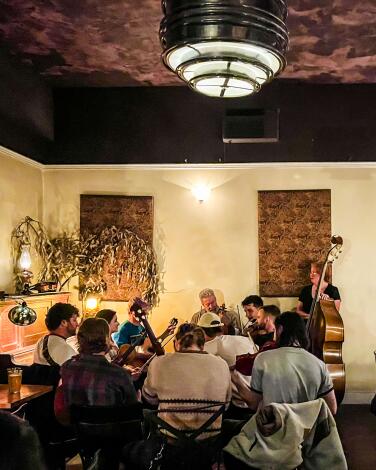
1642
As a casual jazz fan, she’d sometimes play the genre on a sound system, but then several musicians — who played everything from traditional jazz to old-time and Greek folk music — started coming in regularly and asking her if they could play there. “The right people just came my way,” she said.
The dive bar quickly became a go-to spot for local musicians to perform and jam together — as they do every first Thursday on string instruments — and for locals to fill up on cheap beer and wine. The most affordable beer is $6 and wines typically range from $11 to $13. The bar is open from 6 p.m. to 1 a.m. Tuesday through Thursday, from 6 p.m. to 2 a.m. on Fridays and Saturdays and from 6 p.m. to 12 a.m. on Sundays.
It’s easy to stroll past 1642’s plain white building. The only signage is the address number in black above the dark doorway. Still, the welcoming vibe and distinct sounds — you can hear everything from jazz to swing and ragtime — lure people inside.
When I stopped by on a recent Thursday night, I felt like I’d been plopped onto the set of “Bridgerton,” sans the flowy ballgowns, Regency-era tuxedos and fanciful decor, as a large group of string players performed old-time music — a form of North American folk music — in a circle. You would’ve thought they’d rehearsed together from how in sync they sounded. Kelly Marie Martin has been holding the jam session from 8 to 11 p.m. every first Thursday of the month for more than a decade.
The bar typically has live music at least three times a week, including a ragtime-inspired piano set on Tuesdays, a 1920s swing band on Wednesdays and another form of music, sometimes cumbia, on Thursdays. They don’t post a weekly schedule, so it’s best to check the Instagram page for information on performances.
There’s no food at 1642, but on occasion one of the musicians who plays on Wednesdays will sell spicy pickled eggs for $3. (Sadly, he wasn’t there when I visited recently, so I couldn’t try it.) The bar sells only craft beer and wine, and there’s no drink minimum.
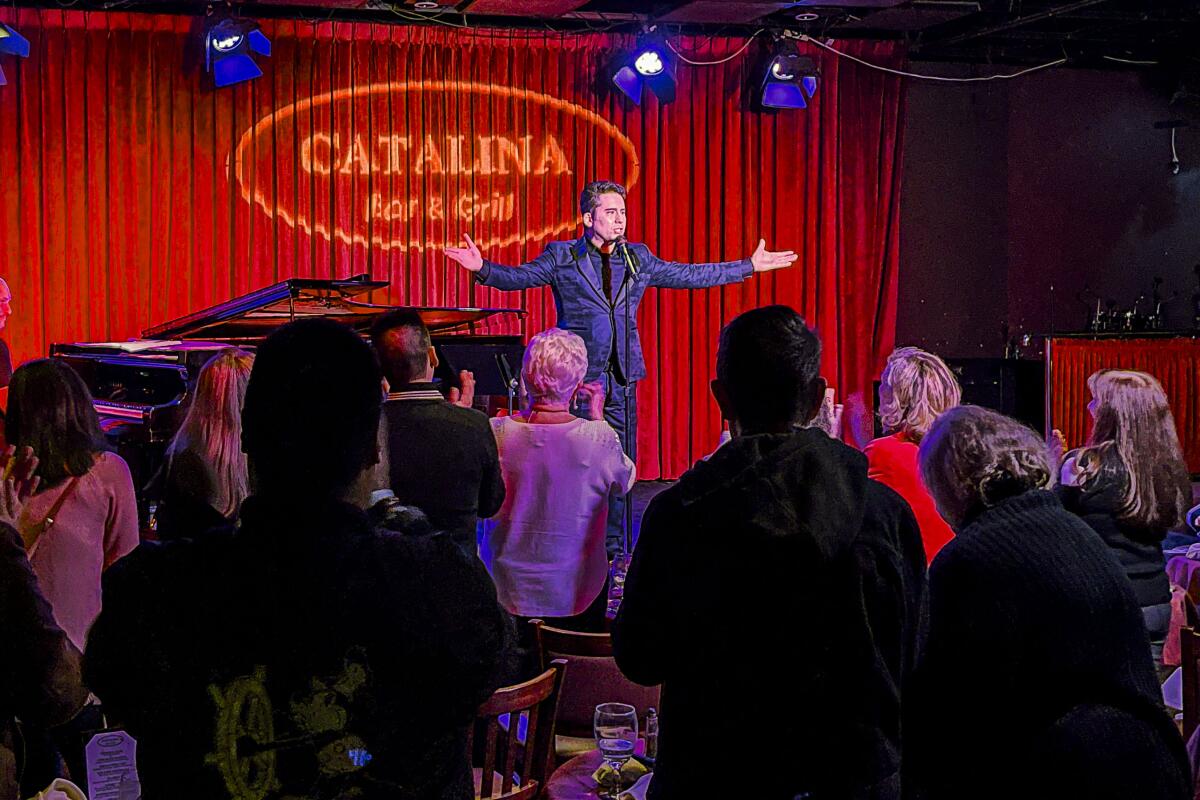
Catalina Jazz Club
In December, my wife and I dropped in to hear singer John Lloyd Young, best known for playing and singing the Frankie Valli role in the stage and screen versions of “Jersey Boys.”
Arriving, I found myself wishing the front doors were under a snazzy boulevard-facing sign. Instead the main entrance is through the parking garage.
But inside, I liked the sound and sightlines. (I recommend the elevated tables along the left wall as you enter.) Young stood in a shiny black suit next to an accompanist at a shiny black Yamaha piano, offering up stylized ’50s pop and (because it was December) lounge-ified Christmas songs.
Despite fighting a cold, Young hit some amazing high notes and delivered the phrasing, tone and showmanship (including some roaming through the audience) that have won him a Tony and a Grammy. I could have done without some of the name-dropping banter between tunes, but the room was mostly full of happy listeners. On the way out, my wife and I overheard an impassioned audience member pulling aside one of the club staffers.
“Thank you for doing shows like this,” the guest said. “Somebody has to!”
Of course it hasn’t been easy. Founded in 1986 by Romanian immigrants Bob and Catalina Popescu, the club moved to its current spot in the heart of Hollywood about 20 years ago. Since her husband’s death in 2008, Catalina Popescu has stuck with the club’s long-standing formula: a snazzy setting for dinner and a steady stream of jazz, usually six nights a week.
Two of the first artists on the stage were Dizzy Gillespie and Buddy Collette, a mainstay of L.A.’s golden era of jazz on Central Avenue. A parade of jazz royalty has followed. When the pandemic deeply threatened the place, a bevy of vocal supporters stepped up (including performers Jane Monheit, Thelma Houston, Steve Tyrell and Ben Vereen) and a GoFundMe campaign raised more than $150,000. Recent performers have included Poncho Sanchez (New Year’s Eve), David Benoit and Steve Gadd.
Besides paying the cover charge (typically $25 to $50 per head, plus a 49-cent music royalty fee), customers are expected to buy dinner or drinks. Main dishes start at $22 (for a vegan burger, which my wife enjoyed). I liked the sausage pasta ($29).
Parking in the adjacent garage is $8 and very convenient. Most nights, dinner starts at 7 p.m. and the show begins at 8:30 p.m. On Sunday nights, those things happen an hour earlier.
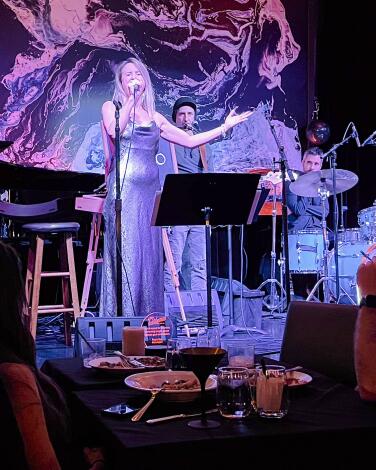
Herb Alpert's Vibrato Grill Jazz
It’s run by Eden Alpert, Herb Alpert’s daughter, and the walls feature several of his abstract paintings. It offers live music just about every night, mostly jazz but also plenty of R&B/soul, a few tribute bands and other genres mixed in.
The main dining room, which has a double-high ceiling and no windows, seats about 100 people under a series of earth-toned chandeliers that look like overturned mushrooms. There’s room for 40 more listeners along the balcony rail upstairs and space for another 20 at the bar.
Just before the show starts, you’ll hear the mellow tones of Herb Alpert’s recorded voice, urging quiet and respect for the performers like an airline pilot making a seatbelt announcement.
The cover charge is usually $25 to $75 and the seats closest to the stage go to those having dinner. Main dishes cost $36 to $120. (If you’re not spending at least $45 on food, you need to spend $20 at the bar.) Shows usually start at 7:30 or 8 p.m.
I visited on an unusual night. The performers were Riccardo Berdini and the Italian Scoundrels, joined by Berdini’s sister, Beatrice, a talented singer. Their show mixed music with mentalism. Between skillfully sung power ballads, Berdini mysteriously and dramatically came up with names and numbers chosen by people in the crowd. There wasn’t much jazz, but there was plenty of interaction with the audience (some of whom should have paid more attention to Herb’s opening words).
Sound quality was terrific.
The venue is part of a high-end mini-mall tucked away in Beverly Crest, a mostly residential area that’s roughly midway between Bel-Air and Sherman Oaks. Self-parking was free and easy.
I enjoyed my filet mignon skewers, mushroom ceviche and Parker House rolls. My wife loved her banana cream trifle dessert. We didn’t love the $18 charge for a bowl of vegan ice cream that we didn’t order — but didn’t realize the mistake until we were out of the restaurant.
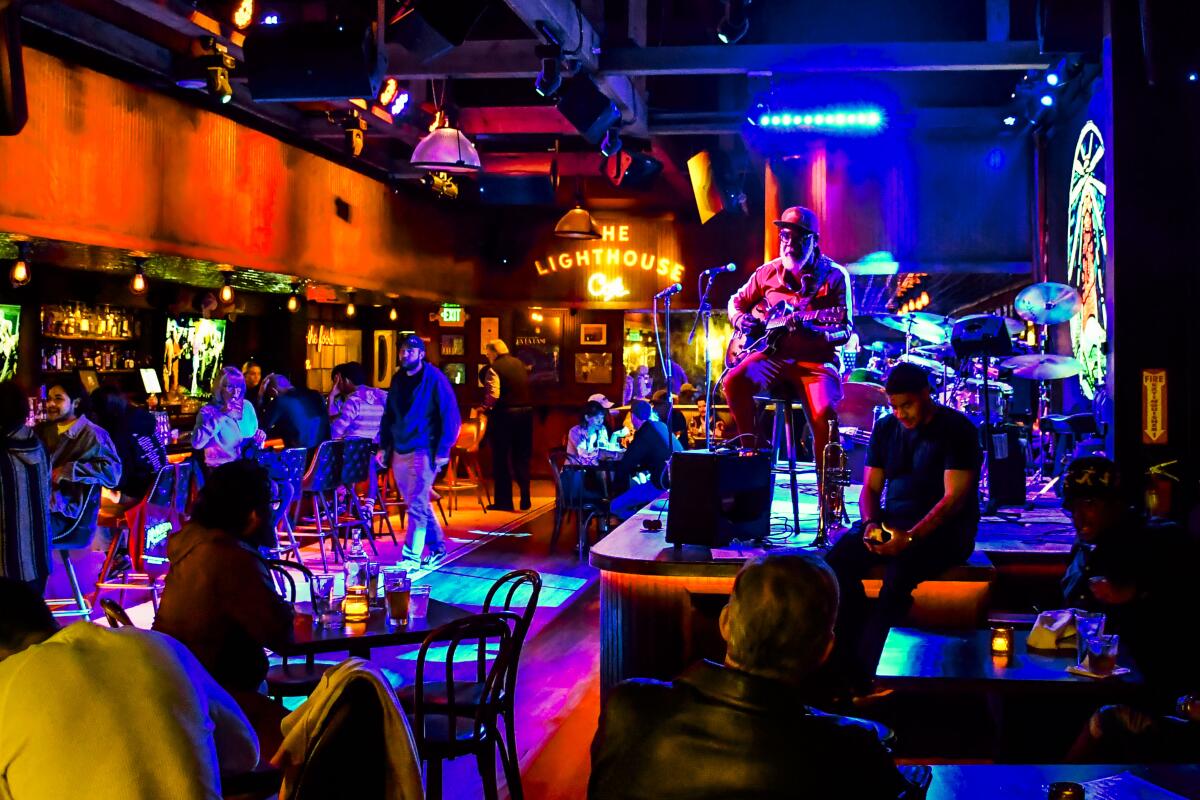
Lighthouse Cafe
Real life is more complicated. You could argue that the Lighthouse’s jazziest days were in the 1950s and ’60s, when performers included Miles Davis, Cal Tjader, Max Roach and Shelly Manne and the talent-filled filled house band was known as the Lighthouse All-Stars. Art Pepper, Ramsey Lewis, Mose Allison and the Modern Jazz Quartet recorded live albums here.
These days most of the jazz happens two days per week: Sunday (over brunch, all ages invited) and Monday (jam session, 21 and over). Live music on other nights is all over the map, including rock, reggae and salsa. But those who come for the jazz are not fooling around.
“This is not just a regular room. This is a serious place for this music,” guitarist Jacques Lesure told the crowd on the Monday I visited. “In 1949, they were in here, doing this. ... We’re creating in the moment and sharing. That’s what’s happening.”
Lesure, who is in “La La Land” and lectures at UCLA, has been leading the jam sessions for about three years. He shares billing with drummer Marvin “Smitty” Smith, who was part of “The Tonight Show With Jay Leno’s” band for about 15 years and controls tempo with no fuss and absolute authority.
The Lighthouse is by far the beachiest bar on this list — just a few strides from the Hermosa Beach Pier — and unlike many places, it has a green room for musicians and a well-elevated stage. There’s no cover charge or minimum order on Monday nights (but of course you must order something).
Most Mondays, Lesure, Smith and the rest of the house band start by playing an hourlong set for a full bar of closely listening jazz people. Look again and you’ll see that some of those close listeners have brought instruments.
After the break, the band plays one more song, then Lesure opens the bandstand to musicians who have signed up to jam. With personnel steadily rotating and musicians often teaming up with strangers, I watched the players tackle standards like “Summertime,” “How High the Moon” and “Take the A Train.” (This A Train seemed to run a little slow, but it stayed on track.)
For anyone nervous about the future of jazz, the Lighthouse jam is a bracing tonic. The players I saw ranged from their 20s to their 60s, a mix of white, Black, Asian American and more.
The room’s capacity is 178 (with room for 46 more on the patio), and the layout includes about 15 tables and 30 stools along the bar.
The club’s role in “La La Land,” Lesure told me, “gave the Lighthouse a greater global reach. ... And it’s given it a multigenerational reach too. ... I don’t know if there’s another place in L.A. that has this history.”
Lesure, a working musician for more than 40 years, wore red glasses and a red tracksuit. During the first set he perched on a stool at the lip of the stage, alternating between rhythm work and solos on his sunburst hollow-body guitar. Besides Smith at the drums, he was joined by pianist Adam Ledbetter, bassist Weldon Scott and trumpeter Chris Lowery.
Along the way, Lesure made sure to point down to the Champagne bucket at the front of the stage. “That bucket there, that’s the musicians’ 401(k) plan,” he said.
Despite the name, the Lighthouse is more bar than cafe. Unlike many other venues on this list, the Lighthouse’s evening shows are all age 21 and over. The short bar menu includes a $16 cheeseburger and $19 codfish tacos. And you can get a beer for $8.
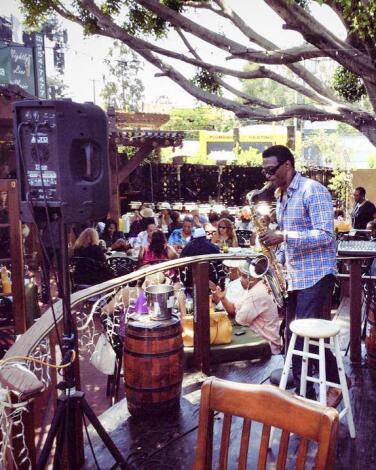
Pip's on La Brea
Owner Derrick Pipkin has been operating Pip’s alongside Argentina-born chef Luis Carrizo Salvat since 2009. While the clientele skews toward a certain age (read: aunties), the combination of live jazz and American comfort food appeals to people of all generations. Order Salvat’s signature empanadas made with ground chicken, sauteed peppers and chimichurri sauce as a starter before moving on to the signature churrasco steak. No matter how the date goes, you’ll go to bed happy.
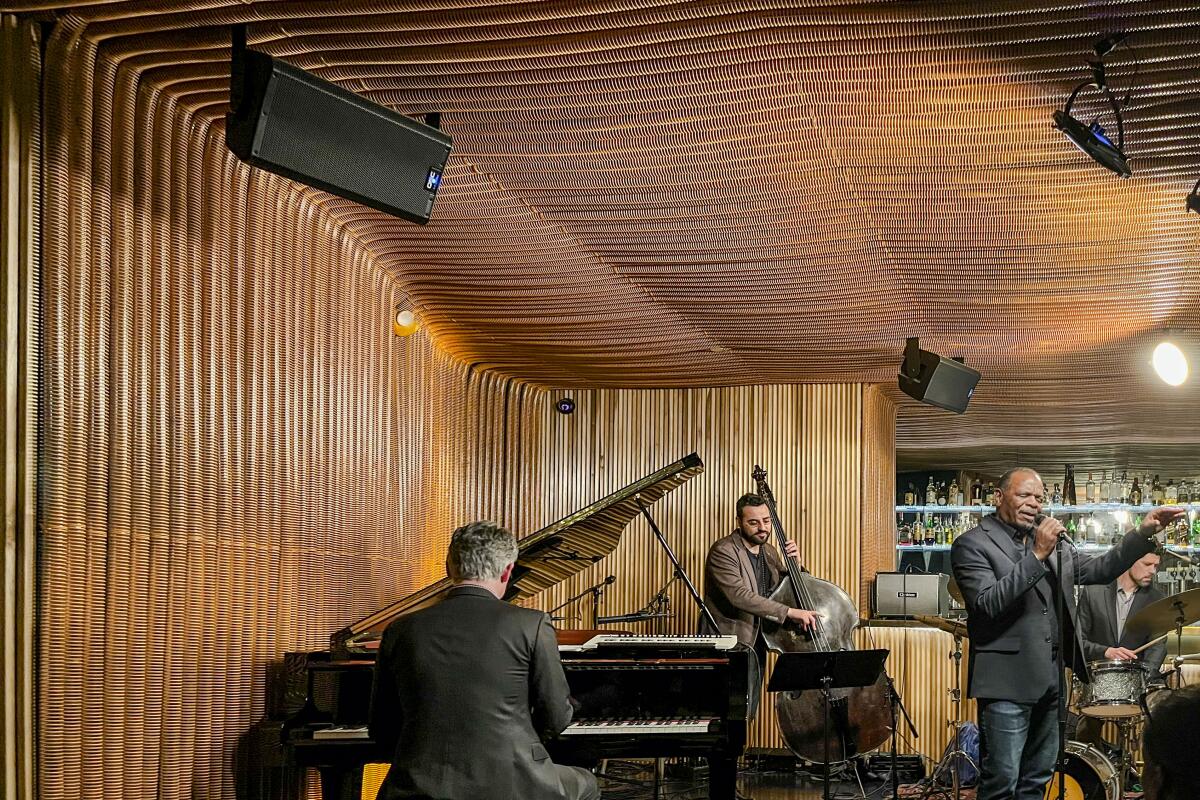
Sam First
While the thought of driving anywhere near LAX may spark disgust, Sam First is one of a few spots that’s actually worth the trek.
Finding the venue can be tricky on your first visit, a common theme with many L.A. jazz venues. I initially made the mistake of turning too soon on West Century Boulevard, but it’s easiest to enter from a small side street, Vicksburg Avenue. I arrived about 20 minutes before the 9:30 p.m. show on a Tuesday. I caught the wave of patrons leaving the 7:30 p.m. show — there are typically two sets per night — and secured one of the eight parking spots in the rear of the building. If you’re not so lucky, you can also find metered parking on Vicksburg Avenue and 98th Street. Nearby Joe’s AutoParks offers a reduced rate of $6.25 for the first three hours. Just stop by the office on your way out and show your Sam First receipt. Then follow the music and glowing yellow light to find the club on the east side of the building.
When I arrived, there was already a line outside of roughly 10 people, but I only waited a few minutes before walking inside the intimate space. It’s best to get here about 30 minutes before showtime.
It was somewhat of a mad dash once the doors flung open as people rushed to get a good seat near the band, which is nestled in front of the bar. As a first-time visitor, this surprised me — after entering, you’re on your own. You can take your pick between leather couches that dot the perimeter or a table with stools in the center of the room, though I recommend the former if you don’t have excellent posture. Some people stood near the back of the venue to get a better view or photos of the band. The venue has a Midcentury Modern touch with mesmerizing, reed-like tubing that stretches from the ceiling to the floor, curving walls and Pinterest-worthy decor.
On this night, Nicolas Bearde, an award-winning vocalist from Oakland, mesmerized the crowd during an hourlong show with the help of Josh Nelson on the keys, drummer Dan Schnelle and Luca Alemanno on the bass. Sam First doubles as a recording studio, so the sound quality is terrific. The venue also livestreams and records video and audio of all its concerts.
Tickets sell out quickly, so it’s wise to purchase them in advance on the website. Shows typically cost $30. You also can watch a show from home by purchasing a livestream ticket for $10. Sam First is open Tuesday through Saturday and, since it’s a bar, it’s 21 and up. There’s a one-drink minimum per performance, though designated drivers can get a complimentary water, coffee or tea. As for cocktails, the venue has wine, beer and classic cocktails, as well as house drinks with witty names like Fizzy Notes (gin, elderflower liqueur, lemon, grapefruit radler) and Violette for Your Furs (violette liqueur, sparkling wine). Sam First also offers bar snacks like a charcuterie and cheese board, artichoke and spinach dip plate (with jicama sticks and gluten-free crackers) and Argentine empanadas from Grand Casino Bakery (with lamb, spinach and cheese, or chicken and mushroom) for $6 each or three for $15.
When the shows are over, people typically hang out inside or on the patio, order more drinks and geek out on music with the friendly performers until the next set starts or until the bar closes. (The closing time is listed as “late” on its website.)
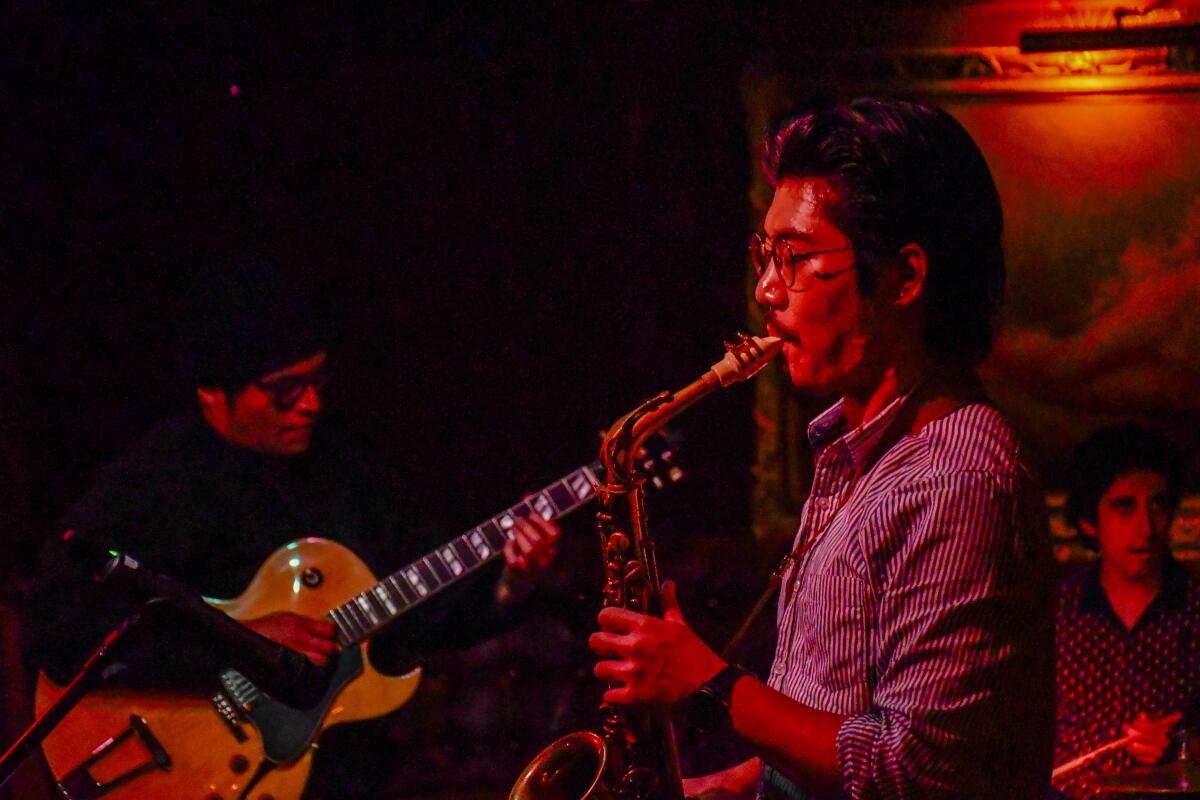
Stowaway
There’s no stage to speak of, but the setting is fairly grand. The furnishings include a curving wood bar, a 7-foot grand piano and, beyond it, a kitschy, old oil painting of a reclining blond burlesque dancer. The menu includes $16 cocktails. Because of the wooden floors and high ceilings, it’s easy to forget that you’re underground.
The club’s Main Room delivers a piano-lounge vibe, and there’s no restaurant element, so everyone must be 21. The Stowaway typically offers a jazz-based Wednesday night “jam hang” and frequently more jazz on other nights, especially Mondays.
On the Wednesday that I visited, trombonist Kenton Luck‘s quartet was hosting the jam. The musicians all looked to be in their 20s, including Lana Drincic on piano, Angelo Velasquez on drums and Peter Gemus on bass. They began a little after 9 p.m., playing a first set for a sparse crowd that swelled around 10:30 p.m.
The newcomers carried gig bags. They were musicians and musicians’ friends, and these players, most of them under 35, took turns joining the jam — a pair of strong vocalists, a couple of saxes, a trumpet, two guitars, a pianist — teaming up on standards like “Georgia” and “Save Your Love for Me.”
For a listener who likes to watch talented young musicians test themselves and sound each other out — with no cover charge — it was a good night.
There’s live music in some genre just about every night at the Stowaway. Sometimes there’s a cover or ticket charge (typically $10 to $25), sometimes not, depending on the performer. The Stowaway’s adjacent Rio Room, separated from the Main Room by a heavy curtain, has its own programming, which often is focused on DJs, vinyl and film.
I parked two blocks from the club in the structure at 213 S. Spring St. and paid $5 for five hours.
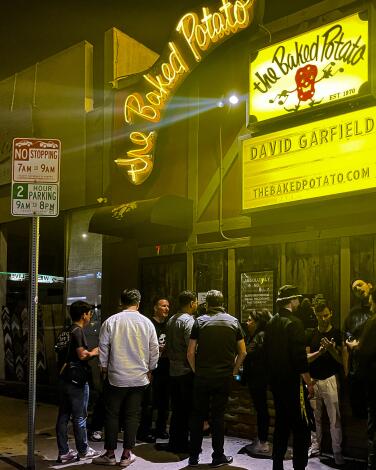
The Baked Potato
The venue is family-owned and has been around since 1970, thanks to Don Randi (Wrecking Crew keyboard player), who created the space to be a musician’s haven. For decades, it’s been the spot where artists of all levels perform and go to see their favorites play. The dive joint is also all-ages.
The intimate space has shoulder-to-shoulder seating, which holds roughly 75 guests. You’re bound to get acquainted when you’re sitting that close to a stranger. Seating is first come first serve, so it’s best to get there early for a good spot.
The Baked Potato usually has two shows per night — at 8 and 10 p.m. — with a $20 to $30 cover charge and a two-drink minimum (drink prices start at $5). You can buy tickets online in advance or at the door. There’s also seating on the back patio for roughly $15, but you watch a live recording of the show on a TV screen. It’s a good option, though, if you want to chat loudly without annoying your neighbors, or smoke. Guests aren’t allowed to take photos or record (visuals or audio) during the performance.
The Baked Potato’s food menu has an array of … you guessed it: baked potatoes. There are 24 types, including a Philly cheesesteak potato, one with broccoli and cheddar cheese, and another with chicken Parmesan. The potatoes are served with a small salad and are very filling even if you share it with someone. (They range from $15.50 to $26.)
Street parking on Cahuenga Boulevard gets more and more difficult as the night goes on, so carve out enough time to find a spot. (The venue recommends you arrive an hour before showtime.)
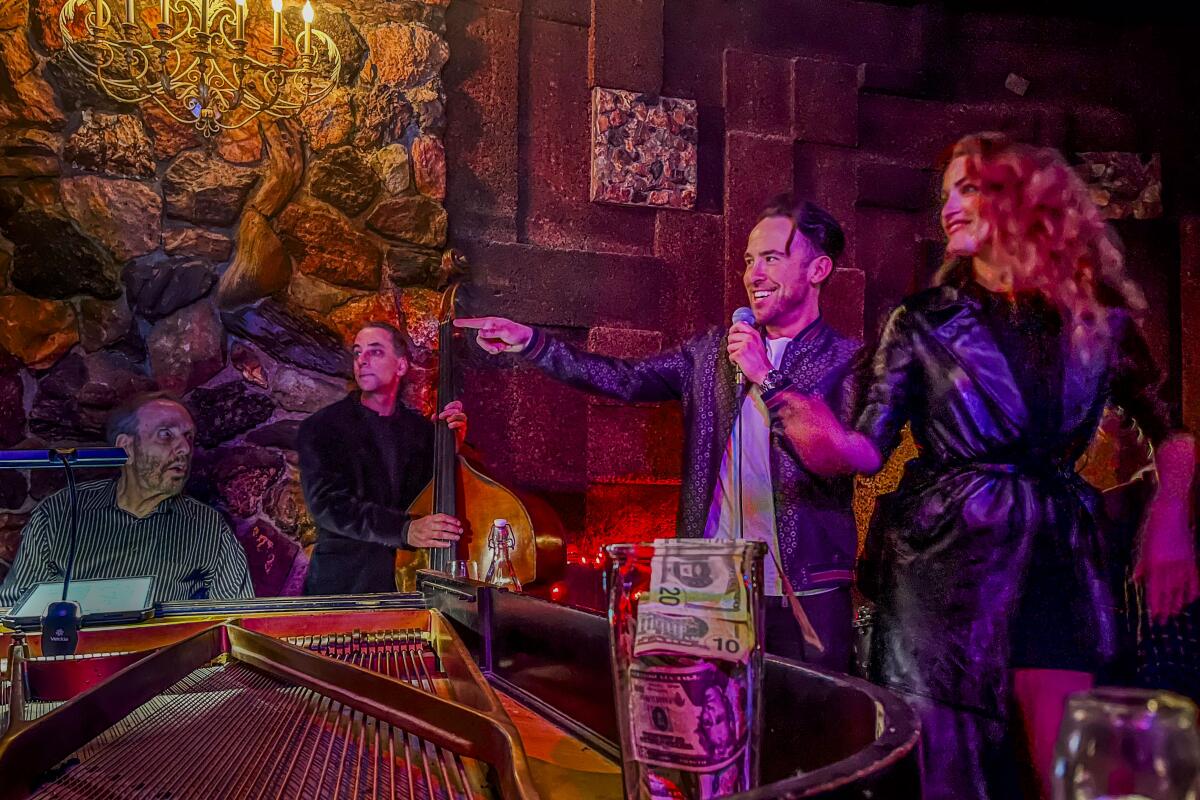
The Dresden
“This is what Larry David might describe as a spite song, a song in the key of F U,” says Matt Forbes before crooning “Cry Me a River.”
Just a few minutes before, willowy Jesse Goddard had been roaming the audience, delivering a lively version of “I Want to Be Loved by You.”
Perhaps forever, mention of the Dresden will move certain Angelenos to fond retellings of the tale of Marty and Elayne, the fearless, caftan-wearing, unhip-yet-hip, husband-wife duo who sang and played piano, flute, drums and bass in the lounge at least five nights a week for nearly 40 years. Nobody who heard their version of “Stayin’ Alive” — in person, or in the 1996 movie “Swingers” — is likely to forget it.
Alas, those days are done. Marty Roberts died at 89 in 2022 and Elayne has moved with her daughter to Las Vegas. But the Dresden’s lounge remains busy with live music, often seven days a week.
Forbes and Goddard, backed by the highly skilled David Moscoe Trio, have been part of the new scene since November 2022. They take over on the second and fourth Fridays of every month. You might hear “Don’t Get Around Much Anymore” or “Autumn Leaves” or “I’ve Got the World on a String” or “My Funny Valentine” or “Stormy Weather.”
There’s no cover charge (with a two-drink minimum on Friday and Saturday nights). Nor is there a spotlit, elevated stage, just a piano in the middle of the high-ceilinged room with just enough space for the other instruments behind it. The singers roam, kid around with the crowd and leave plenty of room for instrumental solos, especially pianist Moscoe. Depending on the time and crowd, you may wind up sitting at a table, at the bar or standing.
The Dresden also does jazz on Wednesdays, when Luke Strand leads a jam session; and Thursdays, when Billy T and the Fam deliver saxophone-led instrumentals.
The Dresden’s dining room (white upholstered booths!) specializes in steak and Italian food (filet mignon, $46; chicken piccata, $27). It’s on the left as you enter the Dresden and the lounge (which serves a bar-food menu) is straight ahead.
Parking, often a challenge in Los Feliz, is $6 to $8 at a pair of private lots, one off the alley behind the Dresden, one at 4640 Melbourne Ave.

The World Stage
The venue, which stands in the heart of Leimert Park Village, holds about 100 people and often books jazz performers for its Friday night concert series. Moreover, the organization runs an instrumental jazz jam session on Thursday nights (hosted by sax player Ralph Gibson; no cover charge but a $5 donation is recommended).
The stage’s programs also include jazz vocal workshops on Saturday afternoons and a big-band rehearsal workshop on Sundays at 5 p.m.
The World Stage’s most celebrated alumnus right now is probably sax player Kamasi Washington, who has released several albums and worked as a sideman in many genres since attending L.A.’s Hamilton High School and UCLA’s Department of Ethnomusicology.
When I stopped in one recent Friday, the performer was bassist Eric Revis, who has recorded eight albums and worked since the 1990s as a sideman to Branford Marsalis. Revis was joined by pianist Joshua White and drummer Clarence Penn, both seasoned veterans with tremendous chops.
It was a small audience — fewer than 20 people, gathered in a space with the feel of a school auditorium, no food or drinks available. World Stage executive director Dwight Trible offered a warm welcome, reminding the room that the organization is “dedicated to seeking light through sound.”
Revis and company delivered an hour of uncompromising jazz. The bearded, beret-wearing band leader played thunderously and sang to himself but barely spoke to the audience. Penn gave such a demonstrative performance at the drums that it verged on interpretive dance.
Admission for Friday night shows is usually $20. The entrance is not from Degnan Boulevard but from the alley in back, where there’s also a fenced patio. On the night I visited, there was ample free parking on the street.
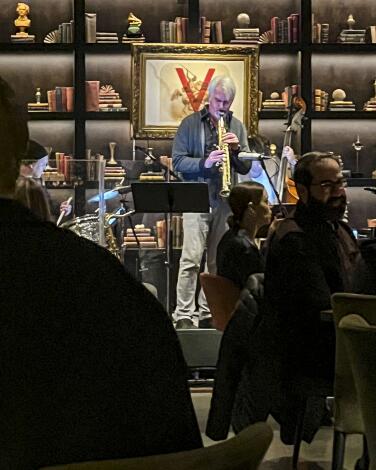
Verse
If it weren’t for the small outdoor seating area, where guests are asked to wait until their table is ready, you’d probably overlook Verse. The venue, which has a black exterior, is tucked on Lankershim Boulevard, walking distance from a car rental company, a chiropractor’s office and a floral shop.
But the mystique of Verse — which is every bit intentional — is part of what makes it so alluring.
When guests walk inside, they are transported into an immersive experience filled with music, food and libations. Its moody lighting and posh decor make it perfect for a romantic date or special occasion. There’s a low stage near the front of the space, where musicians perform various genres including traditional jazz, Latin jazz, blues, soul, swing and ragtime every night. The venue is open Tuesday through Saturday.
Created by Manny Marroquin, a Grammy-winning engineer who’s worked with the likes of Bruno Mars, the Rolling Stones, Jon Batiste and Alicia Keys, the acoustics at Verse are unmatched. There are 52 speakers (11 of which are subwoofers), 28 microphones and 28 sound-absorbing panels throughout the space, all of which make noisy dinner chatter and clinking silverware less distracting. (Marroquin also is the owner of Larrabee Studios, a storied recording studio, that is walking distance from Verse.)
Verse’s music schedule is just as elusive as its location — partly because notable performers are known for doing impromptu sets here. It’s not uncommon for artists to dine at the restaurant after laying a track at Larrabee Studios. Though Verse offers traditional jazz at least three nights a week — usually on Fridays with the Nick Rosen Trio — the days can vary. It’s best to sign up for the venue’s newsletter to keep up with performances for musicians like pop singer Charlie Puth, vocalist and trombone player AlevTina and saxophone player Terrace Martin (who’s recorded a live album there). These shows sometimes have a cover charge that varies, or a food and drink minimum of $75.
Reservations are strongly encouraged for both tables and bar seating, which fill up sometimes a week in advance. There’s no food or drink minimum, nor an age restriction (unless there’s a special event) or dress code.
When I visited on a recent Friday night, it seemed like most of the audience was there for the food (which chef Oscar Torres calls “Angeleno cuisine”) rather than the music, but that didn’t keep them from cheering on the impressive band after each song. Some of my favorite dishes were the braised lamb pasta ($34.20), Hokkaido milk buns with brown butter ($14.20) and a creamy cheesecake with caviar on top for $30.20 (trust me on this one).
Street and metered parking is relatively easy to find on Lankershim Boulevard.
Sign up for The Wild
We’ll help you find the best places to hike, bike and run, as well as the perfect silent spots for meditation and yoga.
You may occasionally receive promotional content from the Los Angeles Times.
